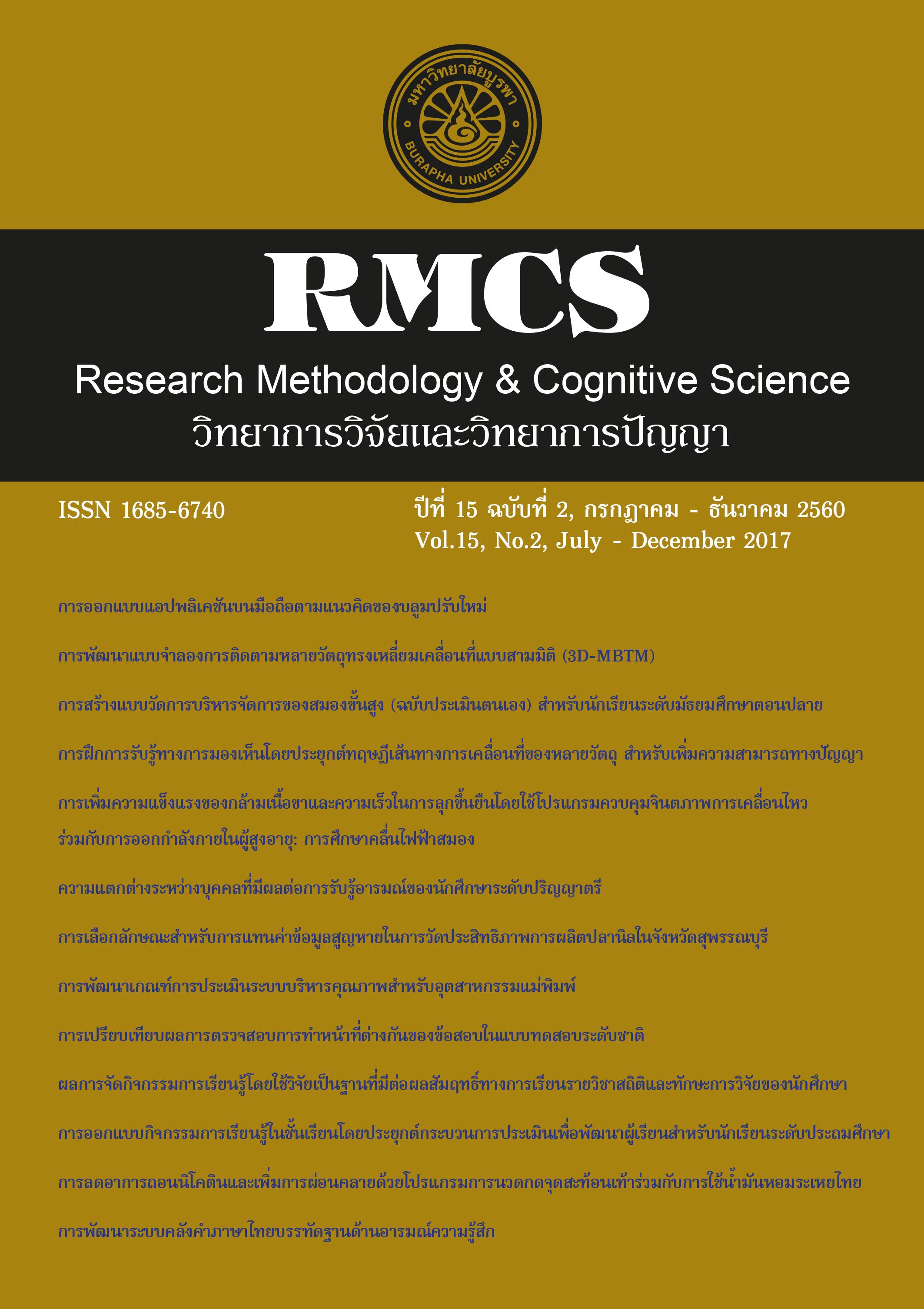Construction of an Executive Function Self Evaluate Report Scale for Grade 10–12 in the Secondary Educational Service Area Office in Bangkok
Main Article Content
Abstract
The purposes of this study were: 1) to construct an Executive Function Self Evaluate Report Scale
(EFSER) for grade 10-12 in the secondary educational service area offce in Bangkok; 2) to verify the
construct validity of the scale; and 3) to derive norms for the scale. The sample consisted of 2,376
grade 10-12 students in the secondary educational service area offce in Bangkok (academic year
2016). Descriptive statistics and scale quality measures were obtained. The validity and reliability
of the scale was further tested by means of second order confrmatory factor analysis.
The research fndings were:
1. The EFSER consisted of two domains; cognitive domain (metacognition, planning/ prioritizing,
organization, time management, and working memory) and behavioral domain (response inhibition,
emotional control, sustained attention, task initiation, flexibility, and goal directed persistence)
across the eleven interrelated sub-domains. The total scale reliability (Cronbach’s alpha) was .92.
2. The construct validity of the EFSER was demonstrated by the ft measures resulting from
confrmatory factor analysis: chi-square = 37.64, df = 29, p = .13, AGFI = .99, CFI = 1.00, SRMR = .02,
and RMSEA = .02.
3. The norms for Executive Function (EF) for grade 10-12 in the secondary educational service
area offce in Bangkok students were constructed as follows: T-scores = 60 or above was deemed
to have a high level of EF; T-scores from 40 to 59 indicated an average of EF level, and T-scores
lower than 40 was indicative of a low level of EF.
Article Details
References
ศิริชัย กาญจนวาสี. (2556). ทฤษฎีการทดสอบแบบดั้งเดิม (พิมพ์ครั้งที่ 7). กรุงเทพฯ: สำนักพิมพ์แห่งจุฬาลงกรณ์มหาวิทยาลัย.
สมพร สุทัศนีย์. (2545). การทดสอบทางจิตวิทยา. กรุงเทพฯ: สำนักพิมพ์แห่งจุฬาลงกรณ์มหาวิทยาลัย.
Anderson, V., & Moore, C. (1995). Age at injury as a predictor of outcome following pediatric head injury: A longitudinal perspective. Child Neuropsychology, 1(3), 187-202.
Barkley, R. A. (2012). Barkley Defcits in Executive Functioning Scale-Children and Adolescent. New York: Guilford Press.
Cohen, R. J., & Swerdlik, M. E. (2010). Psychological Testing and Assessment An Introduction to Test & Measurement (7 ed.). New York: McGraw-Hill.
Dawson, P., & Guare, R. (2010). Executive skills in children and adolescents: A practical guide to assessment and intervention (2 ed.). New York: Guilford Press.
Delis, D. C. (2012). The Delis Rating of Executive Functions. Bloomington, Minnesota: Pearson.
Friedman, N. P., Miyake, A., Corley, R. P., Young, S.E., Defries, J. C., & Hewitt, J. K. (2006). Not all Executive Functions are Related to Intelligence. Psychological Science, 17(2), 172-179.
Gioia, G. A., Isquith, P. K., Guy, S. C., & Kenworthy, L. (2000). Behavior rating inventory of executive function. Florida: Psychologival Assessment Resource, Inc.
Guy, S. C., Isquith, P. E., & Gioia, G. A. (2004). Behavior rating inventory of executive function self-report version. Florida: Psychological Assessment Resources, Inc.
Hair Jr , J. F., Black , W. C., Babin , B. J., & Anderson, R. E. (2009). Multivariate Data Analysis (7 ed.). New Jersey: Prentice Hall.
Huges, C. (2005). Executive Function . In B. Hopkins, G. F. Michel, R. G. Barr, & P. Rochat, The Cambridge Encyclopedia of Child Development (p. 313). New York: Cambridge University Press.
Kaufman, C. (2010). Executive Function in the Classroom: Practical Strategies for Improving Performance and Enhancing Skills for All Students. Baltimore, Maryland: Paul H. Brookes.
Lezak, M. D. (1993). Newer contributions to the neuropsychological assessment of executive functions. The Journal of Head Trauma Rehabilitation, 8(1), 24-31.
Naglieri, J. A., & Goldstein, S. (2013). Comprehensive executive functioning index. Toronto: Multiple Health Systems.
Pascualvaca, D. M., Anthony, B. J., Arnold, L. E., Rebok, G. W., Ahearn, M. B., Kellam, S. G., & Mirsky, A. F. (1997). Attention performance in an epidemiological sample of urban children: The role of gender
and verbal intelligence. Child Neuropsychology, 3(1), 13-27.
Salmpour, V. (2004). Executive Functions and Brain. The Autism Newlink, Fall 2004, 5-6.
Saltus, R. C. (2003). Lack Direction? Evaluate Brain’s C.E.O. New York: New York Times.
Wang, L., Fan , X., & Willson, V. L. (1996). Effects of nonnormal data on parameter estimates and ft indices for a model with latent and manifest variables: An empirical study. Structural Equation Modeling:
A Multidisciplinary Journal, 3(3), 228-247.
Zelazo, P. D., Carter, A., Reznick, J. S., & Frye, D. (1997). Early Development of Executive Function: A Problem-Solving Framework. Review of General Psychology, 1(2), 198-226.
